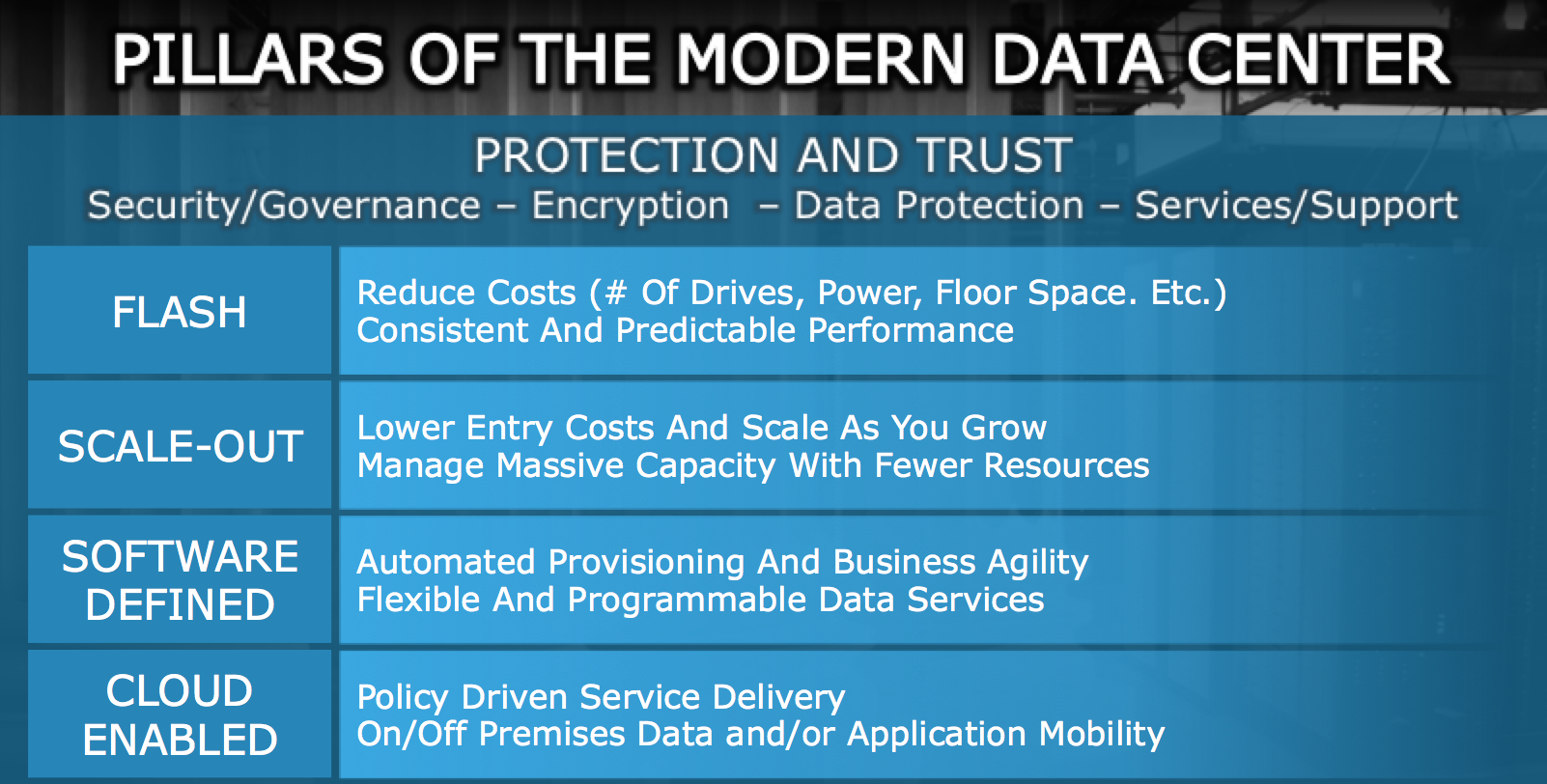Last year we built a data center as part of our efforts to display our full portfolio of products at EMC World. We would have never imagined the level of interaction and interest we received with hundreds of customers coming through the exhibit every day. Our customers, partners, and internal EMC folks love technology and there is no better way to get a ‘feel’ for it than actually touching it.
This year we decided to do the same thing showcasing some of the most exciting technology advances in years. We organized our live modern data center by 5 key pillars:

Flash – everyone understands the benefits of Flash from a performance perspective, mainly delivering predictable low response times. But supply-side innovation is allowing us to embed much denser 3D-NAND technologies delivering unprecedented density and lowering CAPEX and OPEX in ways not possible before. All Flash arrays make more sense than ever and we showcased the coolest kids on the block:
- Unity All Flash systems combining the benefits of flash with unprecedented efficiency and simplicity. Unity is built with end-to-end simplicity in mind bringing innovation like an HTML5-based GUI and a REST API to simplify operations. We also previewed CloudIQ, a cloud-based analytics dashboard to address and manage larger topologies much more proactively.
- VMAX All Flash combining the benefits of flash with uncontended data services and availability features like SRDF. Through the integration with CloudArray customers can be strategic about their hybrid cloud strategy. Flash where you need it and cloud where you don’t.
- XtremIO is the uncontended all flash array market leader delivering integrated copy data management capabilities allowing customers to leverage flash in ways they could never before. Being able to deliver copies on demand means better business agility. Being able to do so without tradeoffs around performance and efficiency is the hallmark of the XtremIO architecture and something competitors struggle to match.
- One interesting addition to our data center this year was DSSD which helps our customers get business outcomes faster than ever before by essentially stripping code out of the IO path while preserving the benefits of shared storage. Server-side flash has often been used but leads to stranded storage and the need to shuffle data around, limited capacity, and no enterprise features to secure the data set. Compare that to DSSD D5, which can provide 144TB capacity, deliver 10MM IOPS at microseconds response times, all in 5U.
Scale-Out – Consolidation remains a key initiative. Doing more with less allows our customers to make investments in growth areas vs. spending time and money to keep the lights on. XtremIO, VMAX, and VMAX All Flash all offer a tightly coupled scale out approach with shared memory, cache, CPU, and other resources that allow customers to consolidate workloads while keeping response times low and predictable. This is ideal for traditional workloads like databases where the time or transaction is often directly tied to revenue generation. For emerging workloads such as HDFS-based analytics the requirement is often more related to capacity, meaning the ability to consolidate large amounts of data under a single management domain. In some cases performance matters here also and Project Nitro set out to deliver this. Think of an Isilon cluster with 3D NAND flash technology to accelerate EDA, Media, and other workloads.
Software-Defined – Business agility requires automation. Automation requires a tighter integration between the orchestration layer and the underlying IT assets. An ideal way to make this connection is ViPR Controller 3.0, which brought some key enhancements to EMC World this year. The metrics are compelling; for example the ability to discover and ingest storage in under 60 seconds. A 63% reduction in time to provision storage and virtual machines is also impressive. To me the time savings of not having to zone the network is equally impressive.
Cloud-Enabled – One of the key drivers in IT is to adopt a cloud strategy where it makes sense. But how do I bridge the two worlds of private and public cloud? Two key use cases come to mind: storage tiering and backup tiering. On display in our data center was CloudArray, which can be encapsulated as VMAX volumes allowing customers to spread the VMAX data services across the system on premises and the cloud, including the newly announced Virtustream Storage Cloud. For the backup use case. administrators can tier backups onto supported public and private clouds as well using Data Domain Cloud Tier.
Protection & Trust – everyone wants to (and should) protect their data. A very broad topic but the most common denominator is a proper data protection strategy. On display were Data Domain combined with the Data Protection Suite (including Networker and Avamar), all with rich integration into ecosystems like Oracle. Of course it’s not all product. At EMC World, EMC also announced MyService360, which simplifies the customer experience by providing a central location for service-centric data via a personalized online dashboard.
All of this was on display and drove some exciting customer, partner, press, and analyst engagement. In case you missed EMC World this year we prepared a quick video to give you a little tour:
Make sure you also go to Chad Sakac’s blog where you have EMC World at Your Fingertips.